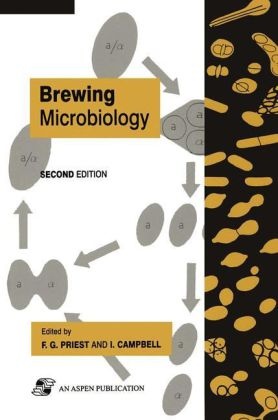Share
I. Campbell, F. G. Priest
Brewing Microbiology
English · Paperback / Softback
Description
During the latter part of the last century and the early years of this century, the microbiology of beer and the brewing process played a central role in the development of modern microbiology. An important advance was Hansen's development of pure culture yeasts for brewery fermentations and the recognition of different species of brewing and wild yeasts. The discovery by Winge of the life cycles of yeasts and the possibilities of hybridization were among the first steps in yeast genetics with subsequent far-reaching consequences. Over the same period the contaminant bacteria of the fermentation industries were also studied, largely influenced by Shimwell's pioneering research and resulting in the improvement of beer quality. Towards the end of the century, the influence of brewing microbiology within the discipline as a whole is far less important, but it retains an essential role in quality assurance in the brewing industry. Brewing microbiology has gained from advances in other aspects of microbiology and has adopted many of the techniques of biotechnology. Of particular relevance are the developments in yeast genetics and strain improvement by recombinant DNA techniques which are rapidly altering the way brewers view the most important microbiological components of the process: yeast and fermentation.
List of contents
1 Systematics of yeasts.- 1.1 Classification of yeasts.- 1.2 Nomenclature of yeasts.- 1.3 Properties for identification of yeasts.- References.- 2 The biochemistry and physiology of yeast growth.- 2.1 Introduction.- 2.2 Yeast nutrition.- 2.3 Yeast metabolism.- 2.4 Yeast propagation.- 2.5 Brewery fermentation.- References.- 3 Yeast genetics.- 3.1 Introduction.- 3.2 Genetic features of Saccharomyces cerevisiae.- 3.3 The need for new brewing yeasts.- 3.4 Genetic techniques and their application to the analysis and development of brewing yeast strains.- 3.5 The commercial use of genetically modified brewing yeasts.- 3.6 Conclusions.- Acknowledgements.- References.- 4 The microflora of barley and malt.- 4.1 The microflora of barley.- 4.2 The microflora of malt.- 4.3 Effects of microorganisms on malting.- 4.4 Effects of the microflora on beer and distilled spirit.- 4.5 Health hazards.- 4.6 Assessment of mould contamination.- References.- 5 Gram-positive brewery bacteria.- 5.1 Introduction.- 5.2 Lactic acid bacteria.- 5.3 Lactobacillus.- 5.4 Pediococcus.- 5.5 Leuconostoc.- 5.6 Homofermentative cocci.- 5.7 Micrococcus and Staphylococcus.- 5.8 Endospore-forming bacteria.- 5.9 Identification of genera of Gram-positive bacteria of brewery origin.- 5.10 Concluding remarks.- References.- 6 Gram-negative spoilage bacteria.- 6.1 Introduction.- 6.2 Acetic acid bacteria.- 6.3 Enterobacteriaceae.- 6.4 Zymomonas.- 6.5 Anaerobic Gram-negative rods.- 6.6 Megasphaera.- 6.7 Miscellaneous non-fermentative bacteria.- 6.8 Detection, enumeration and isolation.- 6.9 Conclusions.- Acknowledgements.- References.- 7 Wild yeasts in brewing and distilling.- 7.1 Introduction.- 7.2 Detection of wild yeasts.- 7.3 Identification of wild yeasts.- 7.4 Effects of wild yeasts in the brewery.- 7.5 Elimination of wild yeasts.- References.- 8 Rapid detection of microbial spoilage.- 8.1 Introduction.- 8.2 Impedimetric techniques (conductance, capacitance).- 8.3 Microcalorimetry.- 8.4 Turbidometry.- 8.5 Flow cytometry.- 8.6 ATP bioluminescence.- 8.7 Microcolony method.- 8.8 Direct epifluorescence filter technique.- 8.9 Protein fingerprinting by polyacrylamide gel electrophoresis.- 8.10 Immunoanalysis.- 8.11 Hybridization using DNA probes.- 8.12 Karyotyping (chromosome fingerprinting).- 8.13 Polymerase chain reaction.- 8.14 Random amplified polymorphic DNA PCR.- 8.15 Summary.- References.- 9 Methods for the rapid identification of microorganisms.- 9.1 What is identification?.- 9.2 Levels of expression of the microbial genome.- 9.3 Identification at the genomic level.- 9.4 Techniques for examining proteins.- 9.5 Methods that examine aspects of cell composition.- 9.6 Developments in techniques for studying morphology and behaviour.- 9.7 Future trends in rapid identification.- Acknowledgements.- References.- 10 Cleaning and disinfection in the brewing industry.- 10.1 Introduction.- 10.2 Definitions.- 10.3 Standards required within a brewery.- 10.4 Cleaning methods available.- 10.5 Soil composition.- 10.6 Process of detergency.- 10.7 Chemistry of detergents.- 10.8 Caustic and alkaline detergents.- 10.9 Sequestrants.- 10.10 Acids.- 10.11 Surface active agents.- 10.12 Disinfectants and sanitizers used in breweries.- 10.13 Oxidizing disinfectants.- 10.14 Non-oxidizing disinfectants.- 10.15 Water treatment.- 10.16 Steam.- 10.17 Summary.- References.
Product details
| Assisted by | I. Campbell (Editor), F. G. Priest (Editor) |
| Publisher | Springer, Berlin |
| Languages | English |
| Product format | Paperback / Softback |
| Released | 25.07.2012 |
| EAN | 9781468400403 |
| ISBN | 978-1-4684-0040-3 |
| No. of pages | 306 |
| Subjects |
Guides
> Health
> Diet
Natural sciences, medicine, IT, technology > Technology > Chemical engineering |
Customer reviews
No reviews have been written for this item yet. Write the first review and be helpful to other users when they decide on a purchase.
Write a review
Thumbs up or thumbs down? Write your own review.

